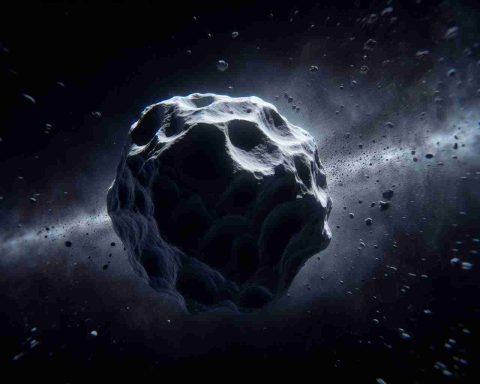Unraveling the Mystery of Earth’s Mini-Moon
In a thrilling revelation, astronomers have uncovered that a small asteroid, designated 2024 PT5, which spent several months as a temporary companion to Earth, could actually be a fragment from our Moon. This near-Earth object, measuring about 33 feet (10 meters) across, caught the attention of space lovers when it was captured by Earth’s gravitational pull in September 2024.
A detailed study published in the Astrophysical Journal Letters highlights that 2024 PT5 is comprised of materials similar to those found in lunar rock samples. The lead researcher, Teddy Kareta from Lowell Observatory, noted that the asteroid’s composition, rich in silicate minerals typically associated with the Moon, served as compelling evidence of its origins.
Discovered by NASA’s ATLAS on August 7, 2024, 2024 PT5 originated in the Arjuna asteroid belt, a region populated by space rocks with similar orbits to Earth. Though it didn’t orbit our planet fully, it temporarily fell under Earth’s gravitational influence.
Notably, this intriguing mini-moon has broadened our understanding of asteroids’ origins. Scientists continue to explore the cosmos with enhanced telescopes, suggesting that even more fragments from the Moon may still be waiting to be found.
Future Implications of Earth’s Mini-Moon Discovery
The discovery of the mini-moon 2024 PT5 raises profound questions about humanity’s relationship with the cosmos, influencing not just scientific inquiry but also cultural perceptions of our place in the universe. As we unveil the mysteries of our celestial neighbors, the symbolism of moons and planetary fragments shifts, suggesting that Earth’s history intersects more intricately with that of the Moon and other celestial bodies than previously understood.
Economically, the implications extend towards space exploration and resource utilization. With private companies accelerating their plans for resource extraction in space, understanding the composition of asteroids like 2024 PT5 can inform strategies for mining materials that could be transported back to Earth, possibly easing resource scarcity in the long run. The potential for discovering valuable minerals in near-Earth objects hints at a new sector in the global economy, one centered around space mining.
On the environmental front, discussions surrounding planetary protection also gain prominence. The collection and use of extraterrestrial materials necessitate stringent measures to maintain environmental integrity, whether in space or upon their return to Earth.
Looking forward, as technological advancements allow us to explore deeper into our solar system, we may uncover further lunar fragments or even evidence of celestial phenomena that challenge our current understanding of planetary formation. The legacies of discoveries like 2024 PT5 underscore an enduring quest for knowledge that will shape our future for generations to come.
Earth’s Mini-Moon: Could It Be a Lunar Love Child?
Understanding the Composition of Mini-Moon 2024 PT5
In an exciting development for astrophysics, the small asteroid 2024 PT5 has garnered attention not just for its size, approximately 33 feet (10 meters) in diameter, but for the potential insights it offers into our Moon’s geology. Recent analyses reveal that this mini-moon, which briefly orbited Earth from September 2024, may actually be a piece of the Moon itself, providing a unique opportunity to study lunar materials without leaving our planet.
Features of 2024 PT5
2024 PT5 is characterized by its rich composition of silicate minerals, which closely resemble those found in lunar rock samples. The study led by Teddy Kareta from Lowell Observatory points out that these characteristics suggest a possible fragmentation from the Moon, hinting at past collision events between Earth and the Moon or other celestial bodies.
Potential Use Cases for Asteroid Research
Research into asteroids like 2024 PT5 can lead to significant advancements in various fields:
1. Planetary Science: Understanding fragment origins helps map historical events in the solar system.
2. Resource Utilization: If more Moon fragments are discovered, the potential for mining resources could become viable.
3. Space Exploration: Insights into mini-moons can inform future missions targeting asteroid mining or lunar exploration.
Limitations of Current Knowledge
Despite the promising findings about 2024 PT5, there are still limitations in our knowledge. For instance, the exact processes leading to its capture by Earth’s gravity remain unclear. Future observations and studies will help to better understand these dynamics.
Innovations in Asteroid Detection
The discovery of 2024 PT5 was made possible through NASA’s Advanced Technology Large Aperture Survey (ATLAS), showcasing innovations in detection technology. Enhanced telescopes and automated monitoring systems allow astronomers to identify near-Earth objects with increasing precision, which is essential for planetary defense strategies.
Predictions for Future Discoveries
As telescopic technologies improve, there is strong potential for discovering more mini-moons and fragments from celestial bodies, particularly from the Moon and Mars. Astronomers predict that the ongoing search may yield new candidates displaying features that could shed light on the solar system’s history.
Security Aspects of Near-Earth Objects
Monitoring mini-moons like 2024 PT5 is crucial for planetary defense. While small in size, even low-mass asteroids can pose risks if their trajectories shift unexpectedly. The analysis of these objects not only provides scientific insight but also contributes to global security initiatives aimed at protecting Earth from potential impacts.
Market Analysis of Asteroid Mining
With the expanding interest in asteroid mining, the discovery of 2024 PT5 adds significant value to the field. Companies are increasingly looking into the feasibility of mining asteroids for precious metals and other valuable resources. The potential economic impact of asteroid mining could reshape industries and create new markets centered around these celestial resources.
For more detailed information on recent astronomical discoveries, visit NASA.
In summary, 2024 PT5 not only enriches our understanding of asteroids and their composition but also opens exciting avenues for future research and applications. As we continue to explore the cosmos, the insights gained from such discoveries will undoubtedly shape our understanding of planetary formation and resource management in the universe.
















